| Penn Hall Behind the cottages, at
the top of the hill, alongside Vicarage Road is Grade II* listed
Penn Hall, built in early Georgian style in the 17th century with early to late 18th century
alterations and additions. Andor Gomme, who was a
professor of English Literature and Architectural
History at Keele University wrote a lengthy description of the
building. He stated that from the outside the house appears
to have been built in the early 18th century, but internal evidence
shows it to be a 17th century house, encased within later walls. He
also stated that there is a largely unaltered 17th century two
storey wing to the right of the main block, which had been used as
the servants' wing in the 18th century and may always have been used
as such. The rainwater heads are dated 1787, which may apply to the
alterations.
|
|

The memorial to Ann Bache Sedgwick in St.
Bart's Church. |
The early 17th century building was owned by W. Hopes and
later acquired by Dr. Raphael Sedgwick, a doctor of physic; and
his wife Anne, who had inherited the estate. They had two children who both died at an early age. John was
born in 1716 and died in 1721, and Ann Bache was born in 1718
and died in 1719. Their mother, Ann died in 1728 and left her
estates to her husband. Ann and Raphael had planned to rebuild
the house as a hospital, but nothing was done until after their
deaths.
In 1729 Raphael Sedgwick married his second wife, Ann Bradley,
who died in 1747. Raphael died a few months later, also in 1747 and
his estates, including Penn Hall passed on to Thomas Bradney, who
had been married to Ann's late sister, Mary Bradley.
In the 1780s, Penn Hall was greatly altered by Thomas Bradney,
using the Sedgwick's design, produced by the architect William
Baker. Thomas Bradney was born in July 1710 and became a Justice of
the Peace for Staffordshire; and High Sheriff of Staffordshire in
1752.
|
|
An early description of the hall can be found in
the
Rev Stebbing Shaw's History and Antiquities of Staffordshire,
published in 1801:
"In Over Penne Thomas Bradney Esq. has completed a good house,
designed by his predecessors, Doctor Sedgwick and his wife, for a
hospital. The situation, near the road to Stourbridge, is very
pretty and pleasant, though open to the north. It is now the
residence of Mrs. Ellen Pershouse, daughter and co-heir of Mr.
Bradney; and commands a fine view of Tettenhall, Wrottesley and the
Wrekin etc." |
|

Penn Hall. From
Stebbing Shaw's History and Antiquities of Staffordshire. |
|
Ellen Pershouse died in 1829 and her son,
William Bradney Pershouse inherited the estate. He was absent
from Penn for long periods. After his death in 1843, the
Pershouse family let the Hall to William Underhill, a
Wolverhampton-based iron stockholder.
By the late 1840s, John William Sparrow and
his family were also living at Penn Hall. The 1851 census
contains the following entry:
|
Penn Hall, Upper
Penn |
| John William Sparrow |
Head, age 31,
Ironmaster, born in Bushbury. |
| Charlotte |
Wife, age 28, born in
Barbados, a British Subject. |
| Charlotte M. |
Daughter, age 4, born
in Penn. |
| John G. |
Son, age 2, born in
Penn. |
| Charles H. |
Son, age 4 months,
born in Penn. |
| Henty C. |
Footman, age 23. |
| Sarah C. |
Nurse, age 28. |
| Elizabeth Hubballs |
Housemaid, age 31. |
| Mary Brown |
Cook, age 29. |
| Betsey Bedford
|
Under Housemaid, age
16. |
| Anne Stokes |
Nurse, age 50. |
The Sparrow family became extremely wealthy
thanks to the profits from their coal mines, ironstone mines,
and ironworks. William Hanbury Sparrow and his brother John Sly
Sparrow purchased Bilston Mill Ironworks, which they ran with
John Walker, an ironmaster. The two brothers founded W. & J.S.
Sparrow & Company, and leased 120 acres of land in Stow Heath,
on the western side of Stow Heath Lane where they mined coal and
ironstone. In 1824 they opened Stow Heath Ironworks on part of
the site, and began producing iron. Before long there were five
blast furnaces, using cold blast, producing hard forge iron.
John Sly Sparrow prematurely died in 1825.
Stow Heath Ironworks were a great success. In 1839, 12,756 tons
of hard forge iron were produced on the site, using four of the
furnaces. By 1873 there were only three furnaces, and an average
of one and a quarter of them were in blast.
In the mid 1840s John William Sparrow
acquired a piece of land alongside Birches Barn Road in Penn
Fields, on which to build a family home. The house became known
as Beckminster House, and John moved there in the 1850s.
The Underhill family remained as tenants at
the hall until the end of the century. By the late 1890s the
hall was owned by George Harry Bradney Pershouse who inherited
it after the death of John Pershouse. George lived at Stafford
House, Victoria Park, Manchester and had little interest in the
Midlands or his property and estates here. He gave his tenant,
Mrs. Underhill notice to leave Penn Hall when the lease to her
late husband expired on Michaelmas day, September 1898. She had
to leave by Michaelmas, 1900. In November 1899, he put the house
and the local estates up for sale. |

| The sale included the following buildings and land at Upper
Penn:
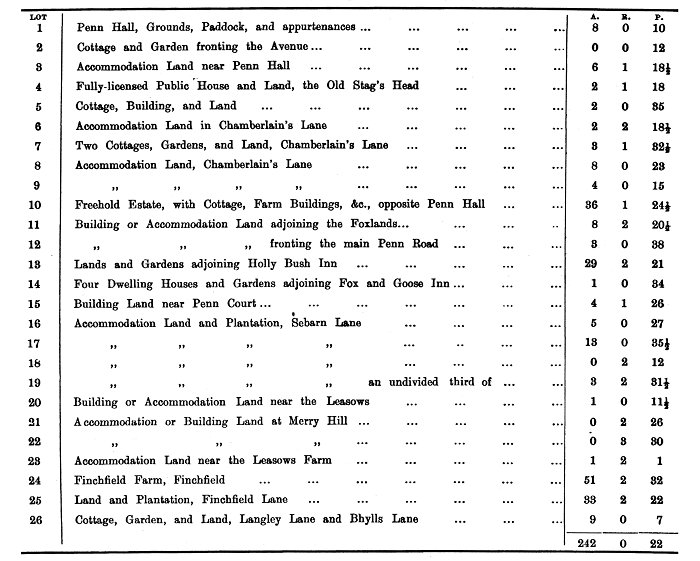
There were also 122 acres of land at Lower Penn, 14 acres at
Wombourne and 9 acres near Dimmingsdale. The estates covered
over 388 acres in total. |

Penn Hall. From the 1899 sale catalogue.
| The sale details for the hall and out buildings were as
follows: |
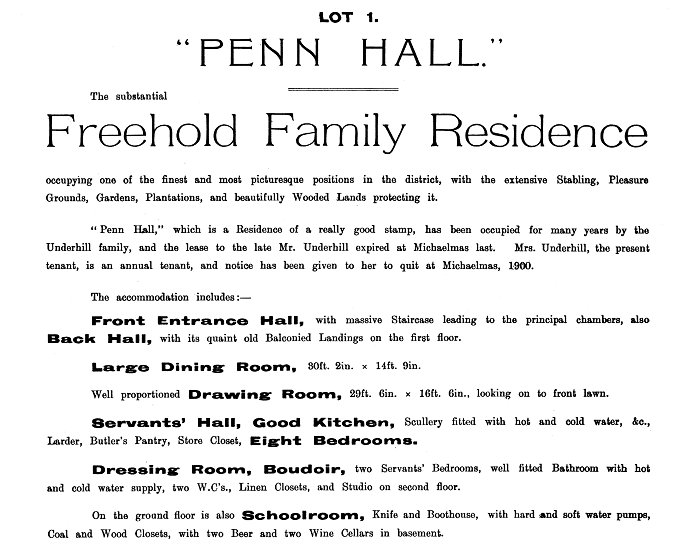
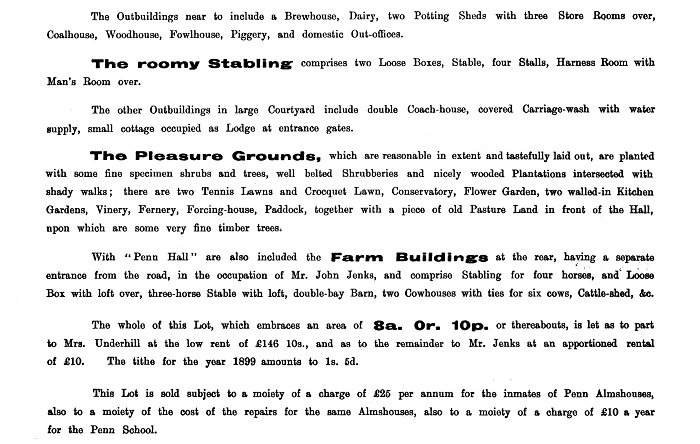
The outbuildings were built in 1734.
| The sale included The Old Stags Head pub: |
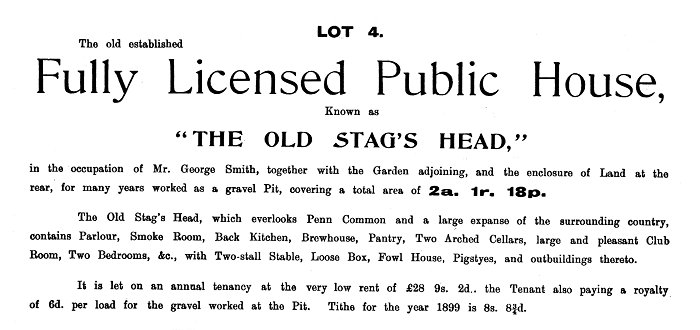
|
In 1902 Penn Hall was acquired by Thomas
Francis Waterhouse who was born at Sedgley in 1866. He became a
solicitor in 1887 and had a successful practice in Wolverhampton
and served as Magistrates Clerk at Wolverhampton and Sedgley.
In 1899 he joined the 3rd Volunteer
Battalion of the South Staffordshire Regiment as a Second
Lieutenant with 'G' Company at Bilston. He was promoted to the
rank of Captain and became a Major in 1906. Two years later he
was promoted to Commanding Officer of the 6th South
Staffordshire Regiment. At the outbreak of the First World War
he was given a Regular Army Commission with the rank of
Lieutenant Colonel and coordinated the recruiting efforts in the
Wolverhampton area.
In October 1914 he took command of the 1/6th
Battalion and in the following year was severely wounded in
France at the Battle of Vermelles when a shell exploded close
by. He lost an eye and needed extensive surgery. In spite of his
wounds, he returned to France in 1918 and was awarded the
Distinguished Service Order. Two years later he became commander
of the Defence Force troops in Wolverhampton.
Although he had an exemplary military
career, his home life was very different. When he purchased Penn
Hall in 1902 he engaged the architect, H. T. Hare to remodel and
improve the building. The work included extensive alterations
which included moving the main entrance to the south side of the
building instead of the west.
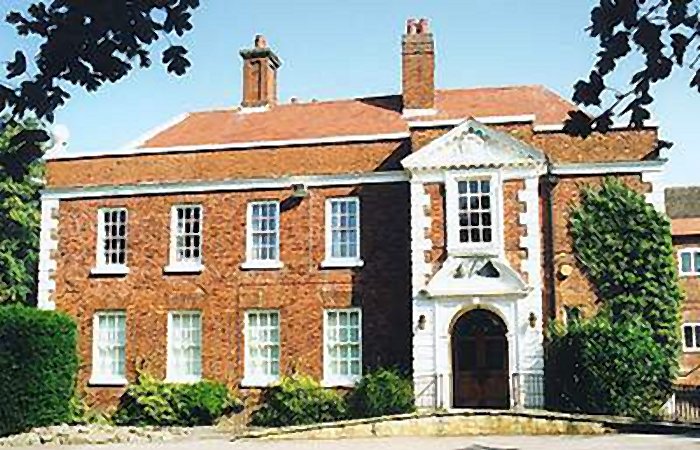
Penn Hall.
By 1907 he was living beyond his means and
later began to misappropriate the funds belonging to several of
his clients. In 1922 bankruptcy proceedings were instigated
against Thomas Waterhouse, who in 1923 appeared at Stafford
Assizes on trial for misappropriation of his clients'
funds. He was found guilty of stealing funds to the value of
£12,684 and was sentenced to imprisonment for nine years. After
his disgrace, he never returned to this part of the country. He
died on the 10th September, 1930 at the age of 65, in Latchmere
House Ministry of Defence Hospital at Ham in Surrey.
In 1924 Penn Hall was sold to Francis J.
Gibbons, a local industrialist who had a large factory in
Wolverhampton, where St. John's Retail Park is today. His firm
made locks, all kinds of builders' ironmongery including
doorplates, knobs, handles, geared fanlight openers, panic
doors, door springs and also 'Cunard' cycles. Francis had
previously been living at The Beeches on Penn Road. He stayed at
Penn Hall until his death in 1948.
Wolverhampton Borough's Watch Committee
(the body responsible for the police) bought the property in
1948 and converted it into a residence for 25 single policemen
with garages for the police vehicles in the traffic section.
Most of the internal features including tapestries, paintings
and fireplaces were preserved.
In 1974 when the West Midlands Police
Authority was formed, the house was sold to Wolverhampton
Council for use as a school to support children and young people
with special educational needs or disabilities, from birth to 25
years of age, and their families.
|
 |
|
 |
|
 |
Return to
The Hollybush |
|
Return to
the beginning |
|
Proceed
to
Vicarage Road |
|